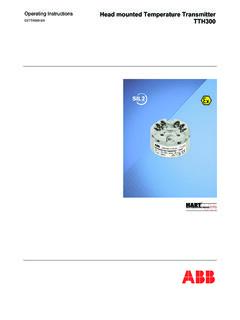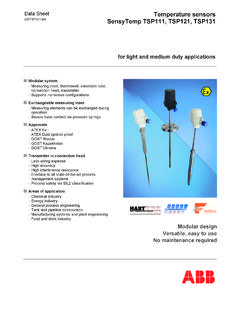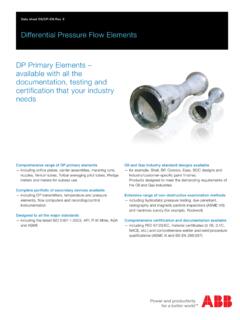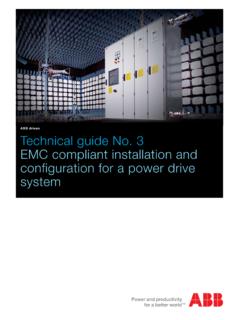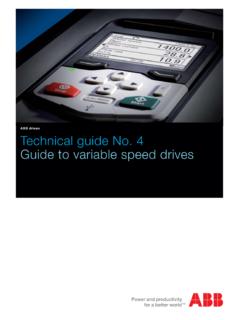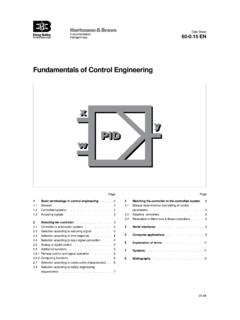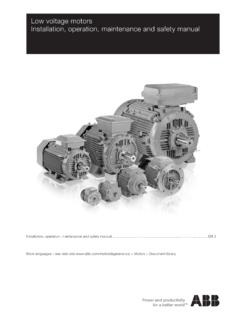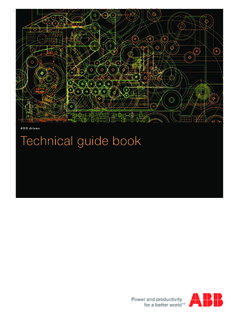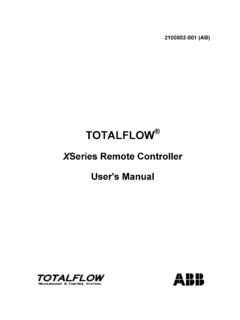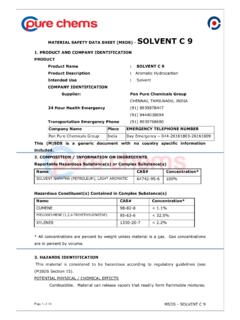Transcription of IET Wiring regulations BS 7671 18th edition - ABB
1 Transient overvoltage protection IET Wiring regulations BS 7671 18th edition4 IET Wiring regulations BS 7671 18th edition The IET Wiring regulations require all new electrical system designs and installations, as well as alterations and additions to existing installations, to be assessed against transient overvoltage risk and, where necessary, protected using appropriate surge protection measures (in the form of Surge Protection Devices SPDs).3 TRANSIENT OVERVOLTAGE PROTECTION - INTRODUCTION Transient overvoltage protectionIntroductionBased on the IEC 60364 series, the 18th edition of BS 7671 Wiring regulations covers the electrical installation of buildings including the use of surge 18th edition of BS 7671 applies to the design, erection and verification of electrical installations, and also to additions and alterations to existing installations.
2 Existing installations that have been installed in accordance with earlier editions of BS 7671 may not comply with the 18th edition in every respect. This does not necessarily mean that they are unsafe for continued use or require key update in the 18th edition relates to Sections 443 and 534, which concern protection of electrical and electronic systems against transient overvoltages, either as a result of atmospheric origin ( lightning ) or electrical switching , the 18th edition requires all new electrical system designs and installations, as well as alterations and additions to existing installations, to be assessed against transient overvoltage risk and, where necessary, protected using appropriate protection measures (in the form of SPDs).
3 Within BS 7671: Section 443 defines the criteria for risk assessment against transient overvoltages, considering the supply to the structure, risk factors and rated impulse voltages of equipment Section 534 details the selection and installation of SPDs for effective transient overvoltage protection, including SPD Type, performance and co-ordinationReaders of this guide should be mindful of the need to protect all incoming metallic service lines against the risk of transient 7671 provides focussed guidance for theassessment and protection of electrical and electronic equipment intended to be installed on AC mains power order to observe the Ligntning Protection Zone LPZ concept within BS 7671 and BS EN 62305, all other incoming metallic service lines, such as data, signal and telecommunications lines.
4 Are also a potential route through which transient overvoltages to damage equipment. As such all such lines will require appropriate 7671 clearly points the reader back to BS EN 62305 and BS EN 61643 for specific guidance. This is covered extensively in the Furse guide to BS EN 62305 Protection Against :Equipment is ONLY protected against transient overvoltages if all incoming / outgoing mains and data lines have protection Wiring regulations BS 7671 18th edition Transient overvoltage protection Safeguarding your electrical systems Why is transient overvoltage protection so important?
5 Transient overvoltages are short duration surges in voltage between two or more conductors (L-PE, L-N or N-PE), which can reach up to 6 kV on 230 Vac power lines, and generally result from: Atmospheric origin ( lightning activity through resistive or inductive coupling (see Figures 02 & 03), and/or Electrical switching of inductive loadsTransient overvoltages significantly damage and degrade electronic systems. Outright damageto sensitive electronic systems, such ascomputers etc, occurs when transient overvoltages between L-PE or N-PE exceed the withstand voltage of the electrical equipment ( above kV for Category I equipment to BS 7671 Table ).)
6 Equipment damage leads to unexpected failures and expensive downtime, or risk of fire/electric shock due to flashover, if insulation breaks of electronic systems, however, begins at much lower overvoltage levels and can cause data losses, intermittent outages and shorter equipment lifetimes (see Figure 01).Where continuous operation of electronic systems is critical, for example in hospitals, banking and most public services, degradation must be avoided by ensuring these transient overvoltages, which occur between L-N, are limited below the impulse immunity of equipment.
7 This can be calculated as twice the peak operating voltage of the electrical system, if unknown ( approximately 715 V for 230 V systems). Protection against transient overvoltages can be achieved through installation of a coordinated set of SPDs at appropriate points in the electricalsystem, in line with BS 7671 Section 534 and the guidance provided in this SPDs with lower ( better) voltage protection levels (UP) is a critical factor, especially where continuous usage of electronic equipment is essential.
8 02 03 DAMAGE> kV (L-PE/N-PE) 01 01 Equipment risk Degradation of electronic systems begins at lower transient overvoltage levels and affects critical electronic systems whenever the impulse immunity of the equipment is compromised. 02 Resistive coupling Resistively coupled transients are caused by differences in potential between two connected earths. 03 Inductive coupling Inductively coupled transients are caused by electromagnetic > 2x peakoperating voltage( 715 V L-N)DAMAGEDAMAGED egradationDegradationSafe Operating AreaSafeOperatingAreaNominalsystem voltage( 230 V)
9 5 TRANSIENT OVERVOLTAGE PROTECTION - SAFEGUARDING YOUR ELECTRICAL SYSTEMS Risk assessmentAs far as Section 443 is concerned, the full BS EN 62305-2 risk assessment method must be used for high risk installations such as nuclear or chemical sites where the consequences of transient overvoltages could lead to explosions, harmful chemical or radioactive emissions thus affecting the of such high risk installations, if there is a risk of a direct lightning strike to the structure itself or to overhead lines to the structure SPDs will be required in accordance with BS EN 443 takes a direct approach for protection against transient overvoltages which is determined based on the consequence caused by overvoltage as per Table 1 Risk Level CRL BS 7671BS 7671 clause adopts a simplified version of risk assessment derived from the complete and complex risk assessment of BS EN 62305-2.
10 A simple formula is used to determine a CalculatedRisk Level CRL. The CRL is best seen as a probability or chance of an installation being affected by transient overvoltages and is therefore used to determine if SPD protection is the CRL value is less than 1000 (or less than a 1 in 1000 chance) then SPD protection shall be installed. Similarly if the CRL value is 1000 or higher (or greater than a 1 in 1000 chance) then SPD protection is not required for the CRL is found by the following formula:CRL = fenv / (LP x Ng)Where.
